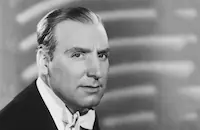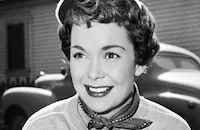The King and the Chorus Girl

Brief Synopsis
Cast & Crew
Mervyn Leroy
Fernand Gravet
Joan Blondell
Edward Everett Horton
Alan Mowbray
Mary Nash
Film Details
Technical Specs

Synopsis
Former king Alfred VII drinks every night because he is so bored. His only two remaining subjects, Count Humbert and Duchess Anna, take him to the Folies Bergère, hoping the show will interest him. He is about to fall asleep in his seat when he notices one of the chorus girls, Dorothy Ellis, and asks Anna and Humbert to invite her to supper. Dorothy arrives at the hotel where Alfred lives only to discover that he has fallen asleep, so she immediately returns home. Anna is impressed by Dorothy's independence and is convinced that Alfred will be intrigued by a woman who does not chase him. She and Humbert visit Dorothy and beg her to resist Alfred in order to interest him in life. The ruse works and Alfred pursues her enthusiastically. He even stops drinking. Then, Dorothy falls in love with Alfred. Realizing that he will probably not marry a commoner, however, she pretends that she is leaving the show to get married. Alfred doesn't believe her and decides to abduct her to his yacht. To convince him that she is telling the truth, Dorothy arranges for Humbert to find Donald, an American waiter who is pretending to be her fiancé. Alfred starts drinking again and by chance walks into the restaurant where the waiter works. He learns that Donald was paid to impersonate a doctor and that Dorothy was paid to stop him from drinking. His feelings hurt, Alfred invites Dorothy to dinner on his yacht, planning to confront her. During the argument, Dorothy blurts out that she loves him before she runs away. Delighted by the news, Alfred searches everywhere for her and finally finds her on board a ship headed for America. He charters the ship, and after he arranges for the captain to marry them, the ship sails to Niagara Falls for the honeymoon.

Director

Mervyn Leroy
Cast

Fernand Gravet

Joan Blondell

Edward Everett Horton

Alan Mowbray

Mary Nash

Jane Wyman
Luis Alberni

Kenny Baker
Shaw And Lee
Ben Weldon
Jacques Lory
Lionel Pape

Leonard Mudie
Adrian Rosley
Ferdinand Schumann-heink
Torben Meyer
Robert Graves
Georges Renavent

Armand Kaliz
Velma Wayne
Georgette Rhodes
George Sorel
Alphonse Martell
Sam Ash
Lee Kohlmar
Gaston Glass
Adele St. Maur
Michael Mark
Crew
Bobby Connolly
Julius J. Epstein
Leo F. Forbstein
Tony Gaudio
Robert M. Haas
Werner R. Heymann
Werner R. Heymann
Ted Koehler
Norman Krasna
Mervyn Leroy
Arthur Lueker
Groucho Marx
Orry-kelly
Thomas Richards
Sherman Rogers
Arthur Sheekman

Film Details
Technical Specs

Articles
The King and the Chorus Girl
The King and the Chorus Girl proved quite timely, since three months before its release King Edward VIII of Great Britain abdicated his throne to marry a commoner, American divorcee Wallis Warfield Simpson. In Britain, to downplay the sensitive "royal" angle, the film was re-titled Romance Is Sacred.
Jane Wyman, another hard-working Warner Bros. star who got her start playing chorus girls, has one of her first featured parts as Blondell's pal. At one point in her career Wyman was hailed as a likely successor to Blondell as the studio's leading brassy blonde with a heart of gold. Beginning with The Lost Weekend (1945), however, Wyman struck out in a very different direction as a brunette dramatic actress. Over the years she and Blondell gradually exchanged positions in the film world, with Wyman emerging as a star and Blondell moving into supporting roles, albeit juicy ones. In their long careers Wyman and Blondell appeared together in four other movies: Stage Struck (1936), Gold Diggers of 1937 (1936), The Kid From Kokomo (1939) and The Blue Veil (1951), for which both were Oscar-nominated Wyman as Best Actress and Blondell as Supporting Actress.
Producer/Director: Mervyn LeRoy
Screenplay: Norman Krasna, Groucho Marx, from their story "Grand Passion"; Julius J. Epstein (dialogue, uncredited), Arthur Sheekman (dialogue and treatment, uncredited)
Art Direction: Robert M. Haas
Cinematography: Tony Gaudio
Costume Design: Orry-Kelly
Editing: Thomas Richards
Original Music: Werner R. Heymann, Ted Koehler
Cast: Fernand Gravey (Alfred Bruger VII), Joan Blondell (Dorothy Ellis), Edward Everett Horton (Count Humbert Evel Bruger), Alan Mowbray (Donald Taylor), Mary Nash (Duchess Anna of Eberfield), Jane Wyman (Babette Latour), Luis Alberni (Gaston).
BW-95m.
by Roger Fristoe

The King and the Chorus Girl
Quotes
Trivia
Notes
The Variety review notes that Fernand Gravet was "imported" by producer Mervyn LeRoy from Belgium. This film was LeRoy's debut as a Warner Bros. producer. It was released soon after the abdication of Edward VIII and contemporary sources note Gravet's physical resemblance to the Duke of Windsor. In a modern source, Groucho Marx writes "any similarity between our story and the love affair between the King of England and Mrs. Simpson was intentional." According to Variety, the car that Gravet drives in the film belonged to the actress Constance Bennett and had been previously used by Mae West in a film. AMPAS files include a request from LeRoy's office to the Academy to add Arthur Sheekman's name to the screen credits as contributor to treatment and dialogue. The Academy agreed, but on the viewed print, Sheekman's name was not present. A Variety news item gives the title of Krasna and Marx's original script as Grand Passion. This was Marx's first onscreen credit on a non-Marx Bros. feature.















